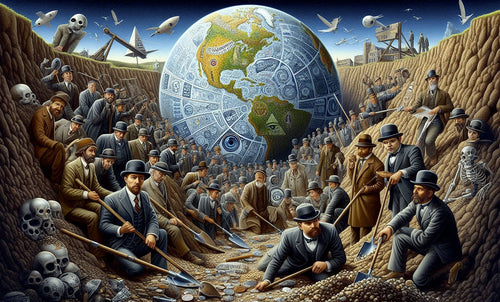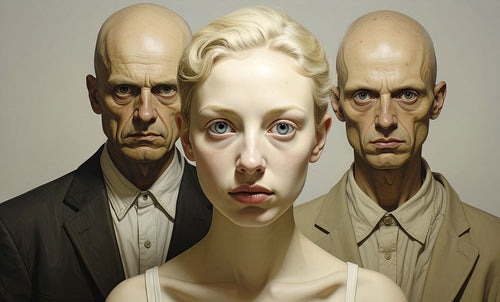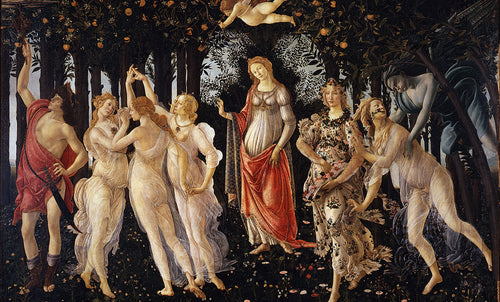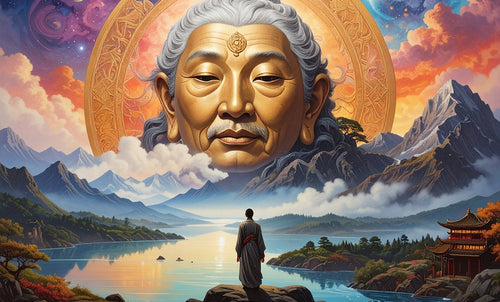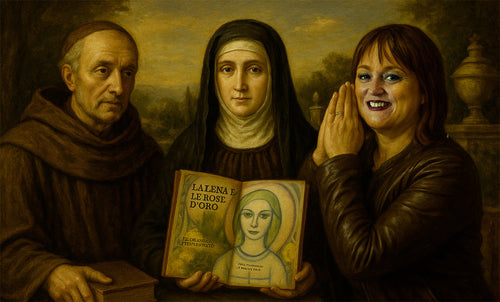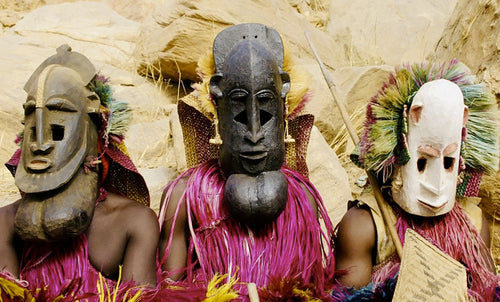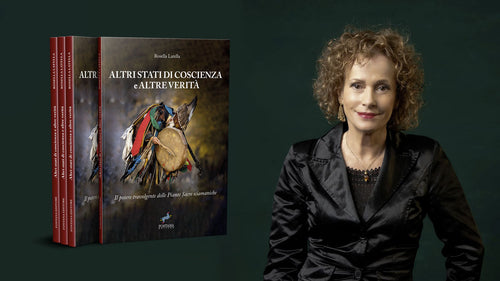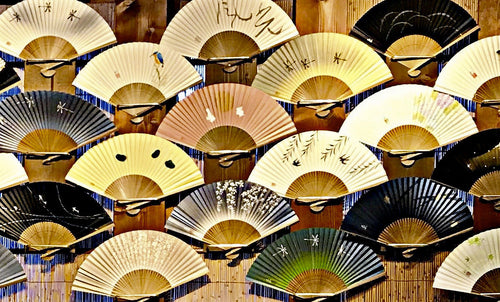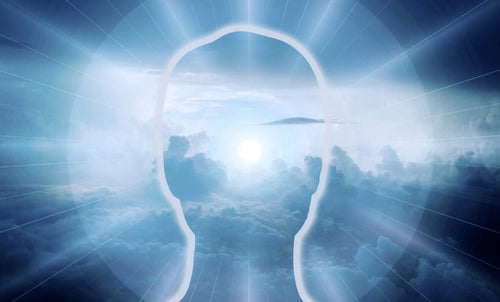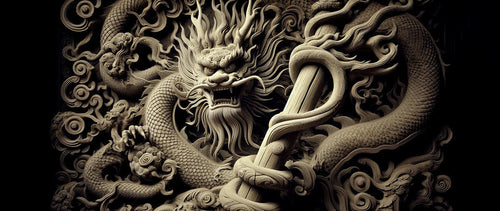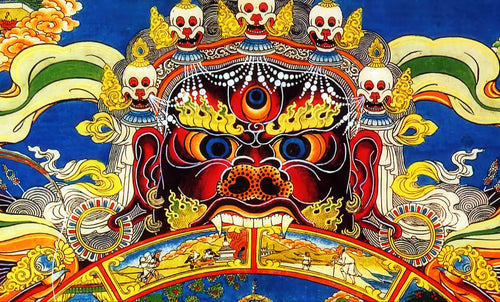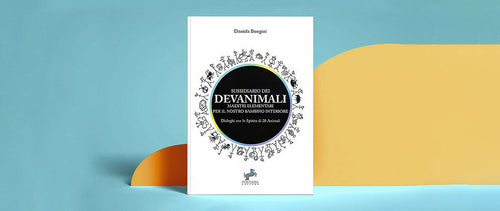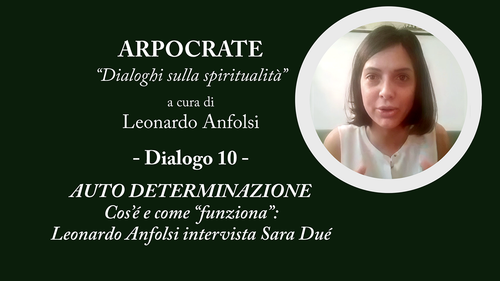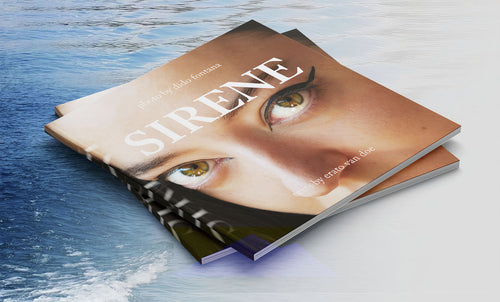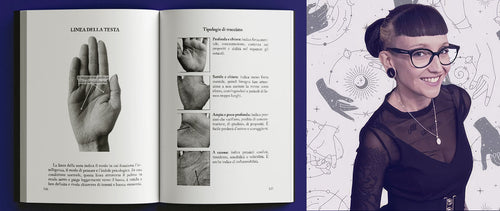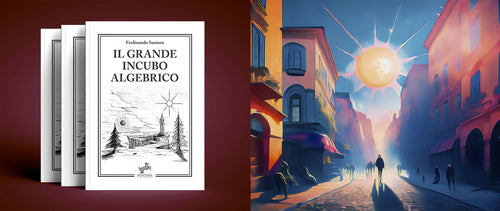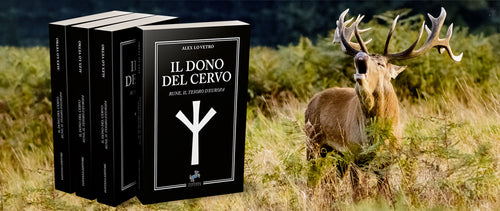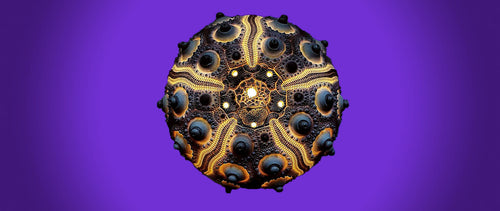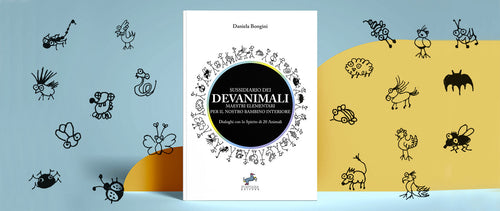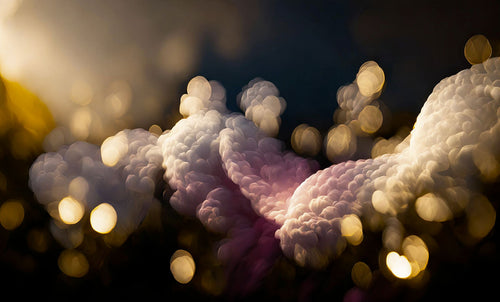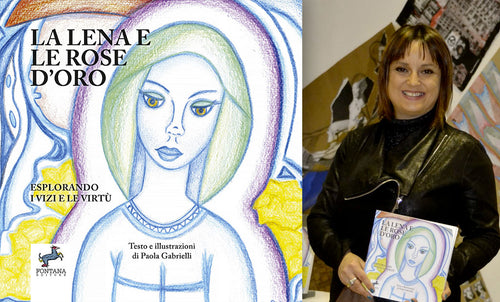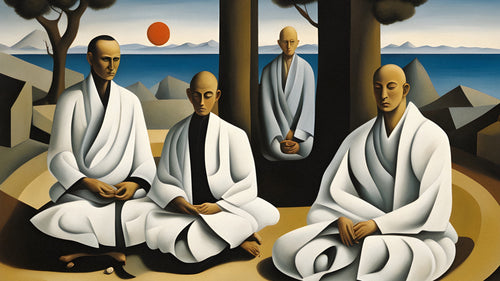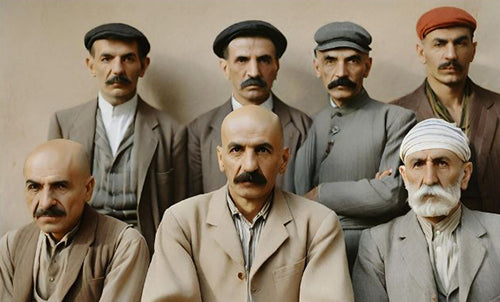
The alchemist stripped bare in the bachelor 1
Arturo SchwarzAlchemy is a word that contains several notions, of which only the most common-and least important-is usually remembered. Most dictionaries encourage our laziness. For instance, the unabridged edition of the Random House Dictionary of the English Language defines alchemy as “an art practiced in the Middle Ages and the Renaissance concerned principally with discovering methods for transmuting baser metals into gold and with finding a universal solvent and an elixir of life.”
Even If I have ever practiced alchemy, it was in the only way it can be done now, that is to say, without knowing it.[1] -Marcel Duchamp
The Philosopher’s stone is nothing more or less than that which was to enable man’s imagination to take a stunning revenge on all things.[2] -Andre Breton
Alchemy is one of the oldest arts of mankind. Its beginning coincides with the dawn of civilization. Egypt, India, and China were the most important centers of alchemical thought and practice in the ancient world. The Royal Art then spread to the Occident through Hellenistic Egypt;one of the earliest treatises on alchemy was written in Alexandria- at the beginning of the Christian era. However, we find records of what might very well be alchemical operations in Egyptian papyri that date back to at least a thousand years earlier.
Alchemy is an esoteric and exoteric adventure; it is a symbolic operation. The transmutation of metal into gold is only the top of the iceberg. The superficial observers who see only this part of the iceberg make their appearance in history at the same time as alchemy itself. An ancient Chinese text denounces such people: “They believe that [alchemy] means to transform stones into gold: isn’t that crazy?”[3]
The material liberation of philosophic gold from vulgar metal is a metaphor for the psychological processes concerned with the liberation of man from life’s basic contradictions. Jung points out that “from its earliest days alchemy had a double face: on the one hand the practical chemical work in the laboratory, on the other a psychological process, in part consciously psychic, in part unconsciously projected and seen in the various transformations of matter.”[4] Elsewhere he draws our attention to the parallel between “the transmutation of metals and the simultaneous psychic transformation of the artifex.”[5]
These contradictions spring from a dualistic view of the universe that postulates the conflicting polarity of all natural phenomena; liberating man from these contradictions thus entails a monistic interpretation of nature. Such an interpretation takes the opposite stand and requires the conciliation, on a higher, transcending plane, of the contradictions that man encounters on the way toward higher self-development: in alchemical terms, on the way toward achieving the status of the homo maior endowed with eternal youth.
But, for the adept to achieve higher consciousness means, in the first place, acquiring “golden understanding” (aurea apprehension) of his own microcosm and of the macrocosm in which it fits. It is in the course of his pursuit of the Philosopher’s Stone that he acquires this new awareness. Thus the quest is more important than its reward; as a matter of fact, the quest is the reward. Alchemy is nothing other than an instrument of knowledge-of the total knowledge that aims to open the way toward total liberation.

Only by acquiring this “golden understanding” will the adept succeed in achieving the higher consciousness that is the first stage toward the reconstitution, at a higher level, of the unity of his divided self. Jung terms this psychological process “individuation,” and he defines it as “the centralising processes in the unconscious that go to form the personality.” He then comments: “I hold the view that the alchemist’s hope of conjuring out of matter the philosophical gold, or the panacea, or the wonderful stone, was only in part an illusion, an effect of projection; for the rest it corresponded to certain psychic facts that are of great importance in the psychology of the unconscious. As is shown by the texts and their symbolism, the alchemist projected what I would call the process of individuation into the phenomena of chemical change.”[[6]
Individuation, in the alchemical sense, entails abolishing the conflicting male-female duality within the integrated personality of the reconstituted Gnostic Anthropos, i.e., the original androgyne-the Homo Maior of mythical times, the Rebis (the double thing) of the alchemist. Andre Breton had already singled out the importance of this aspect of alchemical thought when he wrote: “It is essential, here more than anywhere else, to undertake the reconstruction of the primordial Androgyne that all traditions tell us of, and its supremely desirable, and tangible, incarnation within ourselves.”[7]
The myth of the androgyne runs through our literature from Plato’s Symposium to Balzac’s Seraphita. The concept that everything having shape, quality, and individuation originated from an undifferentiated principle, superior and at the same time anterior to the opposition between Me and not-Me, the physical and the spiritual, inside and outside, not only contains the doctrinal premise of transmutation-creation-but also refers to the sacredness of the Rebis. Bisexuality has always been an attribute of divinity.
Absolute freedom is one of man’s oldest aspirations, and Eliade has pointed out that “to be no longer conditioned by a pair of opposites results in absolute freedom.”[8] But to be able to enjoy this freedom man must first attain integration, become a self. “Only a unified personality can experience life, not that personality which is split up into partial aspects, that bundle of odds and ends which also calls itself man.”[9]
For the alchemist the Rebis was the fruit of the “chymical nuptials” between mercury (the female, lunar principle) and sulphur (the male, solar principle). These “chymical nuptials” are of a basically incestuous nature. What was divided on a lower level will reappear, united, on a higher one.
The incestuous union between Gabricus and his sister Beya. Notice the familiar King/Queen and Sun/Moon archetypal characterisation of the couple (Gabricus and Beya are crowned; the sun and moon are at their feet). Rosarium philosophorum, Frankfort, 1550.
For Jung the chymical nuptials are a metaphor for the reconstitution of the integrity of the split personality through the unification of the anima (female principle in man) with the animus (male principle in woman). This integration is achieved through the reconciliation of opposites (coincidentia oppositorum), the prerequisite for individuation.

But more fundamentally still, bisexuality is the archetypal quality of the creator, while the alchemical incest is the ideal mythical model for the state in which, after all contradictions have been resolved, individuation is achieved and creation becomes possible.
In The Complete Works of Marcel Duchamp[13] I have maintained that the Large Glass is the mythical account of an unrealizable love affair between siblings. The work is understood as an esoteric projection of an unconscious, exoteric, train of thoughts-Marcel Duchamp’s love for his sister Suzanne. Even the unconscious thought of the sexual consummation of the relationship is sufficient to bring about the most drastic of reprisals, death, and thus the Large Glass also reveals the undisguised pattern of one of the world’s oldest and most widespread taboos-the taboo against incest.
It is necessary, however, to understand that the term “incest” is, as Korzybski would say, a typically over/under-defined term, and that it is to be understood “symbolically, not concretistically and sexually. Wherever the incest motif appears, it is always a prefiguration of the hieros gamos, of the sacred marriage consummation which attains its true form only with the hero.”[14]
It should therefore be clear that these patterns were entirely unconscious. The extraordinarily poetic quality of the Large Glass resides precisely in the fact that its creator was led by forces and drives of which he was ignorant. In a lecture he delivered in 1957 on “The Creative Act,” Duchamp declared, “We must then deny him [the artist] the state of consciousness on the aesthetic plane about what he is doing or why he is doing it.”[15] And Jung confirms that “one can paint very complicated pictures without having the least idea of their real meaning.[16] Jung also observes that the alchemist’s quest is again a “psychological projection at the unconscious level.” Discussing the Gnostic philosophy of Zosimos, the Greek alchemist, Jung points out that his philosophy is the outcome of “an unconscious process that works only so long as it stays unconscious.”[17]

If any single painting were to be pointed out in Duchamp’s oeuvre as the one in which the manifest and latent alchemical connotations are most strikingly evident, the choice would no doubt fall upon Young Man and Girl in Spring, painted in 1911. It can only be mentioned here that this pivotal work was immediately preceded by a trilogy of allegorical portraits which suggest a sequence of mythic themes: The Bush (the presentation of the neophyte), Baptism (rites of initiation), and Draft on the Japanese Apple Tree (the attainment of enlightenment).
A discussion of the details of Young Man and Girl in Spring will lead to the realisation that in complexity of theme this painting is second only to the Large Glass; but this is not surprising, since the painting s an anticipation of the Glass.
It might be helpful, before starting a detailed analysis, to point out hat this theme is hinted at both in the double sense of the title-two young people in the “spring” of their life-and in the attitude that the Hero-Virgin pair have assumed in the painting-the two youngsters are sexually attracted to each other. We might see in this attraction a sign of the psychological maturation that favours the development of the individuation process. This individuation process is enriched by the peculiar type of relationship between them as the real relationship of the Brother-Sister pair gradually replaces the mythical relationship of the Hero-Virgin pair. Incest is envisaged here as a means of resolving the contradictions of the male-female duality within the reconstituted androgynous unity of the primordial being, endowed with eternal youth and immortality. In this respect, the basic theme of Young Man and Girl in Spring is a metaphor of the struggle to produce the Philosopher’s Stone.
In Young Man and Girl in Spring the Young Man (Marcel, the future Bachelor of the Large Glass) and the Young Girl (Suzanne, the future Bride) are barely differentiated sexually, and both have their arms lifted to the sky in a Y-shaped figure, a position indicative of their common aspiration-immortality-and of their basic androgynous psychic patterns-an aspiration and a pattern that are closely interdependent. Eliade tells us that when the shaman takes a similar position during rituals he exclaims, “I have reached the sky, I am immortal.”[18] In the Hyperborean and North Atlantic traditions the Y-sign stands for the Cosmic-Man-with-Uplifted-Arms, and again it embodies the concept of immortality through resurrection as well as the concept of the “double” androgynous personality. (In Egyptian, the hieroglyph Kha, which stands for the “double,” is drawn in the Y-form of two uplifted arms,[19] and in alchemy the Y-sign is again the symbol of the androgyne, as may be seen, for instance, in an illustration of Michael Maier’s Symbola aurea, where Albert the Great points to an androgyne holding a Y.)[20] In esoteric writings the Cosmic Man is androgynous since he also stands for the primordial man (the Gnostic Anthropos) who gives birth through a dichotomy to the duality of male and female.
The two young people stand on two separate worlds, implied by the two semicircles from which they strive toward each other. The semicircle on which the Young Man stands radiates a yellowish light: it may well symbolise the Sun. The semicircle on which the Young Girl stands is darker and has a patch of silver-white: the Moon. Similarly, in the alchemical tradition the incestuous Brother-Sister pair is symbolised by the Sun-Moon pair. Their union (coniunctio oppositorum) reconstitutes the original unity of the primordial being, the immortal Hermetic Androgyne (the Rebis). The Young Girl’s head, painted from an unusual angle, disappears behind her uplifted arms; her body looks headless. The dislocation of the head anticipates the position of the head in the Pendu femelle hanging in the upper part of the Large Glass. The term Pendu femelle, i.e., the Female Hanged Body is used repeatedly by Duchamp to indicate the Bride in the Large Glass.
Duchamp has also said that the theme of the Bride was suggested to him “by those booths at the fairs, which were so numerous then, where dummies, often representing the characters of a wedding, offered themselves for decapitation thanks to the skill of the ball-throwers.[21] The thrown-back head of the Young Girl is reminiscent of these dummies. A headless body is not only a symbol of castration; in the esoteric and alchemical tradition, it also stands for the concept of order in the creation of the cosmos as opposed to the disorder of chaos. Neumann points out that “Mutilation-a theme which also occurs in alchemy-is the condition of all creation.”[22]
Furthermore, the meeting of the two young people appears to be both hindered and furthered by a tree whose branches grow between them. The tree both divides and unites them; they reach for its branches and enter thus into indirect contact. The tree as symbol conveys a great variety of meanings.[23]
Basically, the tree is a symbol of the drive toward cosmic totality, of the totality of the cosmos in its genesis and its becoming. It is also the prototype of the hermaphrodite, the synthesis of both sexes; and as the axis mundi, it may act as a mediator between Earth (woman) and the Sky (man). It suggests the prolongation of human life.[24] The tree may also stand for the Adamic Tree, the Tree of Knowledge, which embodies the conflicting but complementary notions of the Tree of Life (or Green Tree) sinking its roots into the sky and the Tree of Death (or Dry Tree) that sinks its roots into the red terra adamica.
In this painting these two aspects of the tree interchange freely. In the alchemical tradition, the Tree of Life is the source of the Sun (on which the Bachelor stands and with which he is identified) and its fruit is the Living Water, the Fountain of Youth. Even though the branches of the tree in the painting are utterly dry (suggesting the Tree of Death), they are also enveloped by a green cloud (suggesting the foliage of the Tree of Life).
The tree in this painting grows from a circle, or rather from a transparent glass sphere in which we might be tempted to recognise an alembic, the alchemical vessel, also called the spherical house of glass (comparable to the Large Glass, which houses the Bride and Bachelor or again the Prison of the King. In this painting the sealed vessel of Hermes imprisons a sexless personage who closely resembles the Mercurius that is often present in the alembic. Mercurius stood for “the hermaphrodite that was in the beginning, that splits into the traditional Brother-Sister duality and is reunited in the coniunctio, to appear once again at the end in the radiant form of the lumen novum, the stone. He is metallic yet liquid, matter yet spirit, cold yet fiery, poison and yet healing draught-a symbol uniting all opposites.”[25] Here Mercurius assumes a typical offering attitude, kneeling and tendering a piece of cloth to the naked Young Man.
To understand the meaning of this offering one must consider the symbolic significance of cloth. According to Durand, woven material is what “opposes itself to discontinuity, to tearing as well as to breaking... it is that which ‘fastens’ two parts which are separated, that which ‘repairs’ a hiatus.”[26] We recall that in this painting the Young Man and Girl are separated by the tree. And this separation is emotional as well as physical. Remarking that the cloth offered by the androgynous personage is pink-a typical color for female garments-we may recall that at Cos the husband wears women’s garments to receive the bride, while at Argos the bride wears a false beard the first night of marriage.[27] (In quite a few photos Duchamp is seen wearing women’s clothes; the best-known example is the photo on the label of the perfume bottle, Belle Haleine, Eau de Voilette, of 1921. And the Mona Lisa of L.H.O.O.Q., 1919, is given a beard by Duchamp.)
The exchange of garments, however, is also often associated with an exploit-conquering a woman’s heart, for instance.[28] The invitation of Mercurius could not be more welcome to the Bachelor, who is separated from his Bride. Obviously, the disguise also symbolises bisexuality, which, in turn, is linked with the human aspiration toward eternity.[29] Durand emphasises this aspect of the cloth’s totalising symbolism, standing as it does for the necessary fusion of the cosmic polarities,:[30] which takes us back to the solution envisaged to repair this hiatus-the alchemical incest. This coniunctio oppositorum-the union of the Brother-Sister pair-takes place in the alchemical vessel, and the fruit of the union is not only Mercurius but also the androgynous original man (the Gnostic Anthropos).

Finally, the circular shape of the “alchemical vessel” in the painting (such vessels are usually an irregular oval) again emphasises the aspiration to reconstitute the original unity; the alchemical ideogram for the “One and All” is a circle-a line or movement that has in itself its beginning and end. In the hermetic tradition it designates both the Universe and the Great Work.”[31]
I have mentioned that the tree grows from this circle, and when the Tree of Death was discussed it was observed that the circle was the schematic representation of its branches. Since the androgynous figure appears in the midst of these branches, it may be identified as the tree’s fruit; we remember, in fact, that the Fount of Youth is the fruit of the Tree of Life and that it is also synonymous with the Great Work (the Opus). The function of the Tree of Life, which is to reanimate the Tree of Death, is thus seen to be fulfilled as, again, Eros defeats Thanatos.
Directly below the central transparent glass sphere, with eyes turned toward the personage it contains, there is another figure, who rests on both the Bachelor’s (Sun) world and the Bride’s (Moon) world. This figure participates in both and mediates between them, reconciling in itself their contradictions. The character is kneeling-halfway between Earth (woman) and Sky (man).
This central personage epitomises the meaning of this painting, which is the accomplishment, on the artistic level, of three primordial and only apparently contradictory aspirations that find gratification within the frame of the alchemical incest: the urge to reconstitute the original unity, the drive toward individuation, and the wish for immortality. In fact, the coniunctio oppositorum of the Brother-Sister pair aims, here again, at resolving the contradictions of the male-female principle in the hermaphroditic, primordial entity which is endowed with eternal youth and immortality.
Let us consider the extraordinary similarities between Young Man and Girl in Spring and its mythical model-the traditional representation of the philosophical androgyne (the Rebis or Compositam de compositis) as may be seen, for instance, in one of the illustrations of Michael Maier’s Auriferae artes (Basel, 1572), where the incestuous Brother-Sister pair again stand on the Sun and the Moon.
In Maier’s illustration the Brother and Sister are united into the Philosophical Marriage by the Universal Spirit that descends upon them under the appearance of a Dove. Each of the three figures in the illustration (the King-Sun-Bachelor, the Queen-Moon-Bride, and the Dove) holds a rose. The roses occupy in the illustration the same position occupied in Duchamp’s painting by the rose-colored garment offered by the Young Man to the Girl. The stems of the three roses cross to form an X-shaped figure that symbolizes the Fire of the Philosophers or the Fire of Love. We have recognized in the pink garment the same allegorical reference to the force of love. Finally, the Universal Spirit (the Dove) finds its allegorical representation in the green cloud that suggests the foliage of the Tree of Life. In the configuration of the tree’s V-shaped diverging branches we can find a trace of the outlines of the Dove’s wings (again both details occupy the same position in the painting and the illustration). Let us also note that, in the alchemical tradition, the Universal Spirit is the Living Water, i.e., the green cloud “dispenser of the beneficent dew” that crowns, in the painting, the Tree of Life, and that it also stands for the aurea apprehensio.
Quite fittingly, 1911, the year that witnessed the realization of the trilogy of allegorical portraits and of Young Man and Girl in Spring, ends with the painting of a grinder, which is a typical alchemical instrument. Coffee Mill is the first of a series of grinding machines; it was followed by Chocolate Grinder, No. 1, 1913, Chocolate Grinder, No. 2, 1914, and Glider Containing a Water Mill in Neighboring Metals, 1913-15.
>A typical alchemic distilling apparatus, the alembic, is to be found in the glass sphere at the center of Young Man and Girl in Spring, and in the Coffee Mill we meet another typical alchemic instrument, the grinding mill. We may see in this the continuity of Duchamp’s thought and the unitary organisation of his symbols. “The mill and the apparatus of distillation are associated in hermetic thought with transformation symbolism in the tradition of alchemy, both as a physical quest for gold and in the psychic dimension of introversion and spiritual rebirth.”[32] Both instruments are refining instruments-the alembic acting chemically, the mill physically. They transmute raw materials into their sublimated form just as Duchamp sublimates his sexual drives into artistic drives.
A detail common to the two paintings executed during the summer of 1912 in Munich, The Passage from the Virgin to the Bride and Bride, reveals one of the most beautiful correspondences between Duchamp’s and alchemical iconography. At the center of both these paintings we can recognise an alembic-the classical androgynous symbol in alchemy. The androgynous nature of the Bride is further confirmed by another fact; Duchamp writes that the spinal column of the Bride is arbor-type, and we may recall again that the tree is a typical symbol of bisexuality. The Bride in this painting thus embodies the realisation of the wishes of the protagonists of Young Man and Girl in Spring. Another detail of this painting may lend even further support to this hypothesis: we may notice that a streamlet of liquid is entering the opening of the alembic. In the alchemic tradition, this operation stands For the alchemical marriage-the union of the Brother-Sister pair. The alchemical marriage is similarly represented in traditional alchemical iconography. For instance, in Hieronymus Bosch’s famous painting The Garden of Earthly Delights, we may note, in a detail, a “hooded crow pouring out from a little phial in its beak a glimmering fluid that flows down into the ovary.” Franger comments that this is “a process that in Bosch’s metaphorical language indicates the celebration of an alchemical marriage.”[33]
The Bicycle Wheel of 1913 is the first Readymade, and it introduces another aspect of Duchamp’s relation to the art of the alchemist. What is of interest in this context is the correspondence between Duchamp’s attitude concerning the Readymades in general, and the kernel of alchemical thought concerning the work of art par excellence, the Philosopher’s Stone. For the alchemist, the Stone “is familiar to all men, both young and old, is found in the country, in the village, in the town, in all things created by God; yet it is despised by all. Rich and poor handle it every day. It is cast into the street by servant maids. Children play with it. Yet no one prizes it.”[[34]
Similarly for Duchamp, art is to be found everywhere, in the most common objects. We only have to open our eyes and our minds to the beauty that surrounds us. Maybe it is this that Duchamp had in mind when, speaking of the Readymades, he declared that any manufactured object can be raised to the dignity of a work of art through the mere choice of the artist. Duchamp entirely rejects the traditional concept of a work of art. “A point that I want very much to establish is that the choice of these Readymades was never dictated by aesthetic delectation. The choice was based on a reaction of visual indifference with a total absence of good or bad taste.”[35]
The difference between artist and layman thus ceases to exist. Lautreamont had already declared that poetry is not to be written only by “poets” but by everybody; and social thinkers have envisaged a golden age in which man will have resolved the problems of social and ideological alienation and in which he will be free to devote himself to ideological and artistic activities with the same proficiency that he will have in productive activities. Marx and Engels saw the advent of such an era as the result of the disappearance of the division of labor.
To fulfill Duchamp’s vision of the disappearance of the distinction between the artist and the layman implies, naturally, a degree of freedom that is not even imaginable today-a kind of freedom that is both a prerequisite for and a consequence of the notion that all men are capable of creating art, a kind of freedom that can only exist in a situation in which there is a future completely open to unlimited adventures, and the creation of such a future is precisely the aspiration of the narcissistic-unitary drive and of the alchemist.
In this context, Duchamp’s adventure with the Readymades heralds the non alienated man of the future and the new dimensions that artistic activity will encompass. In alchemical terms, it epitomises the end result of the successful quest for the Philosopher’s Stone.
(Arturo Schwarz, “The Alchemist Stripped Bare in the Bachelor, Even,” in Anne d’Harnoncourt and Kynaston McShine (eds.), Marcel Duchamp, MoMA, New York, 1973, p. 81-89.)
The Bride Stripped Bare by Her Bachelors, Even, 1915-23, known for short as the Large Glass, together with Given: 1. The Waterfall, 2. The Illuminating Gas, 1946-66, are Marcel Duchamp’s two major works. The latter is in fact the figurative projection in space and time of the former. When one recalls that the Large Glass is the focal point of his oeuvre, the point at which all his more significant earlier works converge, and from which his outstanding later works diverge, one would expect to find in the Large Glass, as well as in its projection, Given: 1. The Waterfall..., the greatest number of alchemical references. This is indeed the case. One would like to point out the numerous correspondences between classical alchemical iconography and the iconographical structure not only of both these works taken as a whole, but also of all the details that compose them. Here, however, we must content ourselves with an analysis of the underlying theme of the Large Glass.
Andre Breton defined the Large Glass as “a kind of great modern legend.”[36] On the secular plane, the theme of the Large Glass is the unrealisable and unrealised love affair between a half-willing but inaccessible Bride (Suzanne, Duchamp’s sister) and an anxious Bachelor (Marcel). The French title of this work, La Mariéé mise à nu par ses célibataires, même, contains a pun in which the whole theme of the work is hidden. One has only to substitute for même the homophone m’aime, and the title reads: The Bride stripped bare by her bachelors is in love with me.
The subtitle of the Glass that describes it as an “agricultural machine” is equally revealing, the reference clearly having to do with the mythical concept of agriculture as a symbolic wedding of Earth and Sky, and plowing being associated with semination and the sexual act.
Duchamp provided us with another clue to the meaning of the Glass when he drew our attention to the fact that it is “a world in yellow.”[37] In the esoteric and alchemical tradition, yellow symbolizes both gold and the Sun; the Sun, in turn, is symbolic of Revelation. And in general, when Revelation is involved, gold and yellow characterize the state of the initiate-Buddhist priests wear robes of saffron. And, as is the nature of symbols, the significance of yellow is ambivalent. Sulphur is associated with both guilt and the devil. This is the color of both marriage and cuckoldry, wisdom and betrayal, the ambivalent couple and the hermaphrodite.
More important still, the notion of color in the alchemist’s system is of cardinal significance-transmutation of one metal into another often boiled down to finding a “tincture” that could change the original color of the baser metal into the yellow color of gold.
When Duchamp called the Large Glass “a world in yellow”, he unconsciously repeated a classical alchemical operation. However, in keeping with his philosophy of an art more mental than physical, instead of a chemical tincture he uses a mental tincture to transmute the transparent, neutral color of glass into the yellow color of the philosophical gold. Thus, the Bachelor is caught red-handed while using a standard alchemical technique!
Detail of lower right-hand corner of central panel of the triptych The Garden of Earthly Delights by Hieronymus Bosch. 1503-4. The Prado, Madrid.
The use of the pun in the title of the Large Glass is indicative not only of its theme, but also of its basically mythical nature. And, like all myths, this one too involves the use of an allegorical and symbolic language in which puns and metaphors disguise its real content, accessible only to the initiate. Duchamp emphasized another characteristic that it has in common with myth-its existence within a dual reality and its resulting ambivalence: “In general, the picture is the apparition of an appearance.”[38]
When the painting Young Man and Girl in Spring was discussed, the full alchemical implications of the brother-sister incest were mentioned. We may now add that the basic pattern of the story that the Large Glass unravels is again a metaphor of the struggle to produce the Philosopher’s Stone. Let us briefly outline this story before seeking the correspondence with the alchemical archetype.
In the Bride’s domain (the upper half of the Glass) three main orders of events are described. First there is the stripping of the Bride, which culminates in a blossoming. This blossoming is “the last state of this nude Bride before the orgasm which may (might) bring about her fall.”[39] Then comes the transmission of the Bride’s desires (also termed love gasoline by Duchamp) to the Bachelor through an extremely complex mechanism which involves the use of a “triple cipher”[40] that permits the messages to pass through the vigilant censorship of three Nets (also called Draft Pistons: squarish apertures seen in the Top Inscription or Milky Way).
Finally there is the unrealised meeting of the Bride’s and the Bachelor’s desires in an area of the Bride’s domain delimited by the chance configuration obtained by firing nine shots at the Glass.
The complex mechanism of the long-awaited meeting of the Bride and Bachelor ensures that no contact will take place between the Bride and the Bachelor-even though only their psychic expressions confront each other here.
In the Bachelor’s domain (the lower half of the Glass) a symmetrical pattern of three orders of events takes place. First the birth of the Bachelor’s desires-the Illuminating Gas-in the Nine Malic Molds that Duchamp appropriately calls Eros’s matrix. Then the long and tormented journey of the Bachelor’s desires on their way to the meeting with the Bride’s. In the case of the Bachelor’s the obstacles are even more formidable. His desires will first have to pass through the narrow nine Capillary Tubes, where they will lose their sexual identity-they will be castrated (“cut in bits”).[41] Then they will be stopped by the seven Sieves, who have a dual conflicting role: on the one hand they filter, censor, and “straighten out”[42] the Bachelor’s desires; on the other, after performing this first role, the Sieves help these desires to reacquire their sexual identity. But the Bachelor’s vicissitudes are still not over. His desires will be channeled into the Toboggan, crash (die) three times at its base before resurrecting and being allowed to rise triumphantly toward the Bride’s domain through the three Oculist Witnesses.
Go to part two >>>
Notes:
[1] Marcel Duchamp, quoted by Robert Lebel in L”Art magique, ed. Andre Breton and Gerard Legrand (Paris: Club Francais de l’Art, 1957), p. 98.
[2] Andre Breton, Second Manifesto of Surrealism (1930), in Manifestoes of Surrealism, trans. Richard Seaver and Helen R. Lane (Ann Arbor: University of Michigan Press, 1969), p. 174.
[3] Quoted by Pierre Prigent in Dictionnaire des symboles (Paris: R. Laffont, 1969), p. 18.
[4] Carl Gustav Jung, Psychology and Alchemy (1944), “The Collected Works of C. G. Jung,” Bollingen Series XX, vol. XII, ed. Sir Herbert Read, Michael Fordham, Gerhard Adler, trans. R. F. C. Hull (New York: Pantheon; London: Routledge & Kegan Paul; 1953), p. 258.
[5] C. G. Jung, Alchemical Studies, “The Collected Works... ,” Bollingen Series XX, vol. XIII, ed. Sir Herbert Read, Michael Fordham, Gerhard Adler, William McGuire, trans. R. F. C. Hull (Princeton: Princeton University Press, 1967), p. 159.
[6] Jung, Psychology and Alchemy, p. 462.
[7] Breton, Prolegomena to a Third Surrealist Manifesto or Not (1942), in Manifestoes of Surrealism, pp. 301-2.
[8] Mircea Eliade, Mephistopheles et l’Androgyne (Paris: Gallimard, 1962), p. 150.
[9] Jung, Psychology and Alchemy, pp. 78-79.
[10] Ibid., p. 317.
[11] Marie Delcourt, Hermaphrodite: Mythes et rites de la bisexualite dans l’antiquite classique (Paris: Presses Universitaires de France, 1958), p. 124.
[12] Ibid., p. 10.
[13] Complete ... (New York: Abrams, 1970).
[14] Erich Neumann, The Origins and History of Consciousness (1949), trans. R. F. C. Hull (New York: Harper & Brothers, 1962), vol. I, pp. 16-17.
[15] Marcel Duchamp, “The Creative Act,” Art News (New York), vol. LVI, no. 4 (Summer 1957, contents incorrectly dated Summer 1956), p. 28
[16] C. G. Jung, “A Study in the Process of Individuation” (1950), The Archetypes and the Collective Unconscious, p. 352. “The Collected Works ...,” vol. IX, part 1; for publishers, see note 4.
[17] Jung, Psychology and Alchemy, p. 288.
[18] M. Eliade, Shamanism: Archaic Techniques of Ecstasy (1951), Bollingen Series LXXVI, trans. Willard R. Trask (New York: Pantheon, 1964), p. 404.
[19] Julius Evola, La tradizione ermetica nei suoi simboli, nella sua dottrina e nella sua ‘Arte Regia” (Bari: Laterza, 1931), p. 102.
[20] Michael Maier, Symbola aurea (Frankfort: Luc Jenn, 1617).
[21] Duchamp interviewed by Jean Schuster in “Marcel Duchamp, vite,” Le Surrealisme, Meme (Paris), no. 2 (Spring 1957), p. 143.
[22] Neumann, The Origins and History of Consciousness, vol. 1, p. 121.
[23] M. Eliade, Patterns in Comparative Religion, trans. Rosemary Sheed (Cleveland and New York: World, 1963), pp. 265-330; and Gilbert Durand, Les Structures anthropologiques de l’imaginaire (Paris: Presses Universitaires de France, 1963), pp. 365-72.
[24] Durand, ibid., pp. 367-69.
[25] Jung, Psychology and Alchemy, pp. 281-82.
[26] Durand, Les Structures anthropologiques de l’imaginaire, p. 347.
[27] Plutarch, The Greek Question (58th) and the Virtues of Women; quoted by Delcourt, Hermaphrodite, p. 7.
[28] Delcourt, ibid., p. 14.
[29] Ibid., p. 64.
[30] Durand, Les Structures anthropologiques de l’imaginaire, p. 348.
[31] Evola, La tradizione ermetica.... p. 32.
[32] Lawrence D. Steefel, Jr., The Position of “La Manic mise a nu par ses celibataires, mime” (1915 -1923) in the Stylistic and Iconographic Development of the Art of Marcel Duchamp, Ph.D. dissertation (Princeton University, 1960), p. 38.
[33] Wilhelm Franger, The Millennium of Hieronymus Bosch: Outlines of a New Interpretation, trans. Eithne Wilkins and Ernst Kaiser (London: Faber and Faber, 1952), p. 138.
[34] Barcius, Gloria mundi, alias Paradysi tabula, in Musaeum hermeticum, Part. VI (Frankfort, 1678).
[35] The first draft of this talk has been published in Marcel Duchamp, “Apropos of Readymades,” Art and Artists (London), vol. I, no. 4 (July 1966), p. 47. My quotations are taken from the final, unpublished text given to me by Duchamp.
[36] Andre Breton, “Phare de La Mariee,” Minotaure (Paris), no. 6 (Winter 1935), pp. 45-49. English translation published in View (New York), Marcel Duchamp Number, series V, no. 1 (March 1945), p. 9.
[37] Notes and Projects for the Large Glass, ed. Arturo Schwarz (New York: Abrams, 1969), Notes 9 and 10.
[38] Ibid., Note 36.
[39] Ibid., Note 1.
[40] Ibid., Note 81.
[41] Ibid., Note 100.
[42] Ibid., Note 100.

